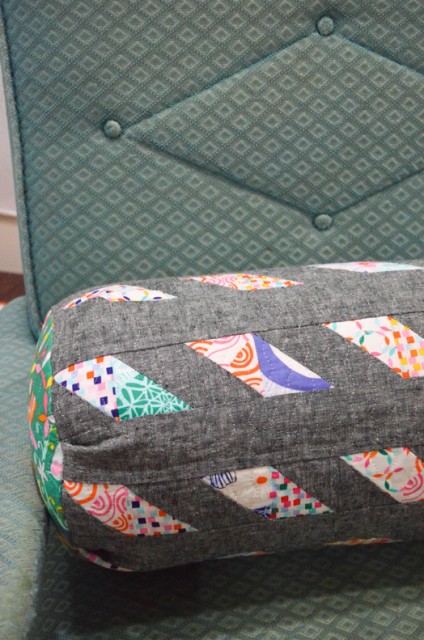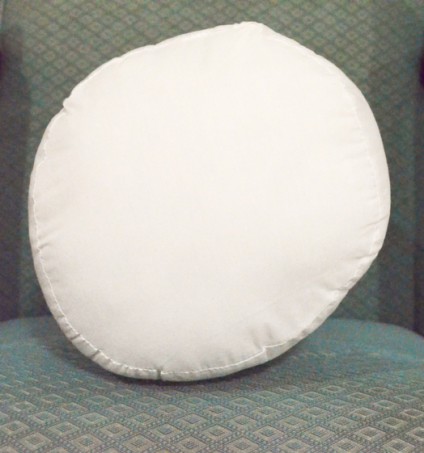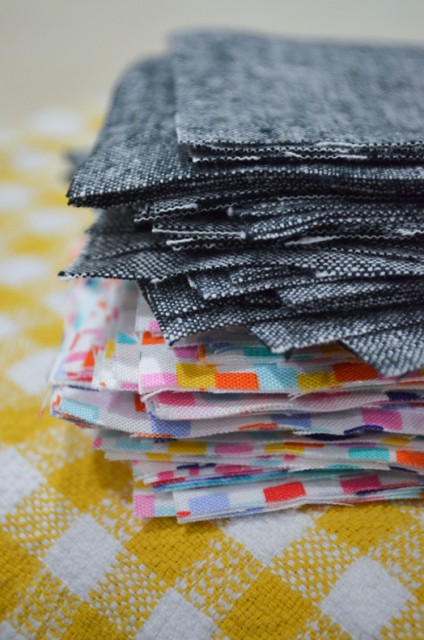
Sooooo….
Today I get to be a part of the Pillow Collective!

Amy and I thought it would be fun to highlight some fun, fast projects that you can use to spruce up your living space during these cold dreary months before spring comes.

I’ve been wanting to make a bolster pillow for some time, and I always have need to use up my leftover Half Square Triangles, so I figure a bolster made from HST’s is perfect, right?
Now, I know we’re supposed to share a tutorial for our pillow, but in this case I’m going to have to give you rough instructions, because so much about this pillow depends on your pillow form. Sorry for the lack of pictures, it was late when I was sewing and the pictures didn’t turn out at all. I’ll snag you some as soon as I can.

So, HST bolster pillow…here we come!
First off, snag a bolster pillow form. Mine was pretty big, but I’m sure they come in all different sizes.

Measure the length and the circumference of the pillow, write those numbers down.

Then, trace the end of the pillow on a sheet of paper.

Make (70) Half Square triangles by cutting (35) 3″ colored squares, and (35) background squares. Using my quick HST method, make (2) HSTs with one colored and one white square, by sewing two season either side of the midline, and cutting the pieces apart. Press toward darker fabric.
Cut (6) 2 1/2″ strips and (2) 6″ strips th
at are an inch or two longer than the bolster.
Lay out your half square triangles in your desired pattern, using 2 1/2″ strips in between the rows. Place 6″ sashing on the top and bottom of the rows. Stitch blocks together in rows, pressing seams open. Stitch rows to sashing, press toward sashing. Finished panel should be large enough to cover the bolster with about 6 inches of overlap. (Remember when you measured the circumference and length, those will come in handy here.)
Layer quilted panel with batting and backing and quilt as desired. I used metallic thread and quilted it in a wavy line.
Hem the 6″ top and bottom sashing strips by folding under 3/4″, and then folding 3.4″ again. Press and topstitch in place.
Cut out 2 circles for the ends of the pillow, using the traced circle from the end of the pillow. Layer circles with batting and backing and quilt as desired.
Pin panel to the circle, right sides together, allowing the panel to overlap about 3 inches.
On my bolster, I placed a few pleats in my panel, to help it lay more smoothly.

Stitch around the circle. Repeat on opposite side.

Turn pillow cover right side out, and place pillow form inside. It should be snug.

On my pillow, I finished with a large button, which helps the envelope style closure from gaping open.

Plus, who needs an excuse to use a 2″ button?

Hope you love my bolster as much as I do!

Have so much fun on the rest of the Pillow Collective stops today, and throughout the week!
xoxo
April
PS Visit the other stops on the Pillow Collective today and throughout the rest of the week!
- Amy Ellis
- April Rosenthal
- Lisa Calle
- Natalia Bonner
- Megan Bohr
- Amanda Woodruff
- Heather Valentine
- Amy Smart
- Vanessa Christenson
- Maureen Cracknell
- Amanda Jean Nyberg
- Dana Bolyard
- Christina Lane
- Heather Bostic
- Audrie Bidwell
- Amanda Herring

Love your bolster April! Thanks for sharing all the details :)
That’s a nice way to use up the extras. Might to have try it someday.
Gorgeous!
How cute is that? I love that you were able to use some of your scraps to make it… that’s ALWAYS great.
Beautiful and really unique looking! It’s going on my gotta-make-it list. I would also LOVE to photo link to this in an upcoming Daily DIY if you didn’t mind.
Thank you! And a photo link would be lovely! Email me: april at prairiegrasspatterns dot com, and I’ll send you a good picture. :)
Oh Thank you for this great pattern! I was just pinning a note, to check the pillow forms available before I start cutting… then I was that you had left instructions for that, as well. Super!
These factors alone seem to far outweigh any increase in energy consumption for lighting.
The growing medium is mostly air, plus whatever medium
was used to grow the plant from a seed or cutting (usually rock wool or
perlite. Urban Homesteading: Self-Sufficiency on a City Lot.
Hi there to every body, it’s my first pay a visit of this web
site; this website consists of amazing and truly excellent data
in support oof visitors.
Hi blogger i see you don’t monetize your page. You
can earn additional money easily, search on youtube for:
how to earn selling articles